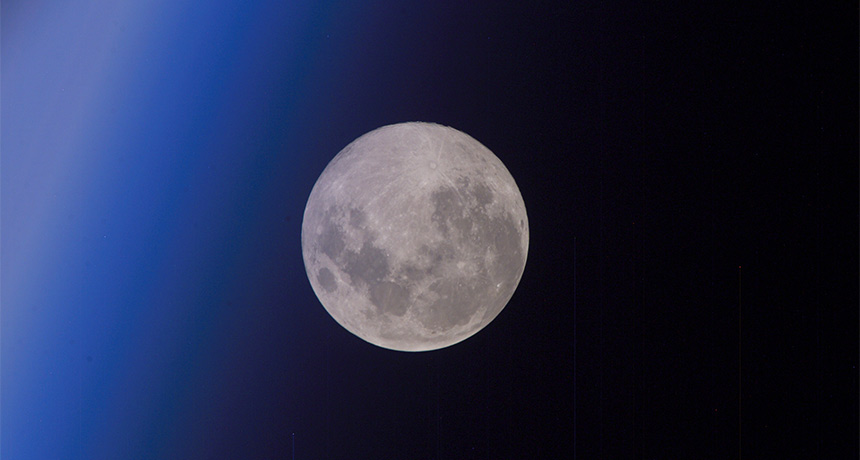Meteorites may be excavating lunar water
Molecules kicked up by incoming space rocks suggest water is buried in the moon’s soil

Water molecules near the moon hint that our natural satellite has water under its soil.
NASA
Meteor showers bring moon sprays. A spacecraft spotted extra water around the moon when the moon passed through streams of cosmic dust that can cause meteor showers on Earth.
The water was probably released from the lunar soil by tiny meteorite impacts, scientists say. Those random impacts suggest water is not isolated in freezing dark craters. It likely is buried all over the moon. The new observations also suggest that the moon has been wet for billions of years.
There has been some uncertainty over the years about whether the moon has water. Samples of lunar soil brought back by the Apollo astronauts had suggested that the moon was bone dry. But in the last decade or so, several remote missions have found water deposits on the moon. There have even been signs of frozen surface water in regions that lie in a permanent shadow near the poles. Moon rocks have turned out to have water in them, too.
“We knew there was water in the soil,” says Mehdi Benna. He is a planetary scientist at the NASA Goddard Space Flight Center in Greenbelt, Md. He and colleagues discussed the moon sprays April 15 in Nature Geoscience. What scientists didn’t know was how widespread that water was, or how long it had been there.
Benna and his colleagues used observations from NASA’s LADEE spacecraft. It orbited the moon from November 2013 to April 2014. Some of LADEE’s instruments were spectrometers (Spek-TRAH-meh-turz). They break apart light to reveal the chemical fingerprints of whatever they are studying. These instruments detected dozens of sharp increases in the abundance of water molecules around the moon. Those molecules were in the moon’s exosphere. That’s a thin layer of gas molecules that cling to the moon.
When the team looked at their data closely, they realized some of the measurements coincided with the moon passing through known clouds of space dust. When Earth passes through those clouds, the dust burns up in Earth’s atmosphere. That produces annual meteor showers such as the Leonids and the Geminids. But the moon has no true atmosphere, just its exosphere. Bits of dust from the same showers strike the moon’s surface directly. And they will stir up what lies beneath.
Benna’s team calculated that only meteorites heavier than about 0.15 gram (0.005 ounce) could have kicked up the water. And those micro-rocks could go pretty deep into the soil. That means the top 8 centimeters (3 inches) or so of lunar soil is dry. Smaller impacts would have released water if any were in the top 8 centimeters. Beneath that dry coating, however, is a global layer of soil laced with frozen water — ice clinging to dust grains.
The moon is by no means soggy. Squeezing half a ton of lunar soil would yield barely a small bottle of water, Benna says. “It’s not a lot of water by any measure, but it’s still water.” And it’s too much water to have arrived at the moon recently, he says. The moon may have held on to at least some of this water since the time of its formation.
Future studies could help figure out whether and how that water could be useful for human explorers.
The finding is “plausible and certainly provocative,” says Erik Asphaug. He is a planetary scientist at the University of Arizona in Tucson. “It’s the kind of paper that is good to see published so we can debate it.”







